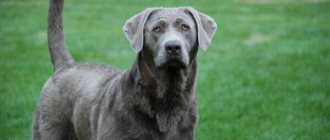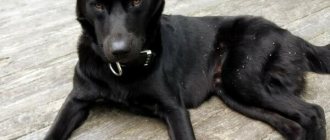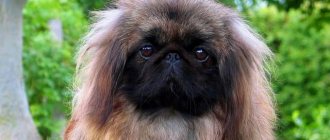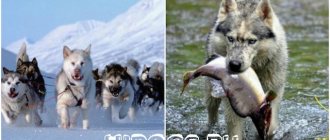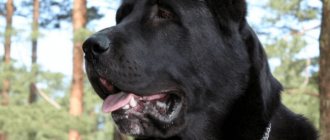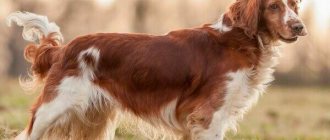Interest in dogs performing a variety of roles remains at a high level. Particularly popular are breeds endowed with hunting and guard instincts. The value of such dogs increases if they are used as rescuers, guide dogs, and companions.
The black Labrador meets all these criteria. It is believed that the first representatives of this breed appeared in eastern Canada on the island of Newfoundland. But other colors have also been established as a modern standard.
Genetics of the Labrador breed
The English Kennel Club in 1903 recognized only the black color of Labradors, whose history began in the 19th century.
In heredity, the shade of the coat plays a priority role, especially when breeding pedigree animals. A combination of genes responsible for this indicator has been identified. This necessitates a thorough study of the pedigree when purchasing puppies. However, experienced dog breeders are confident that this knowledge may not be enough.
The dominant genes are B and E, which give the coat a black tint. Recessive analogues (b and e) are responsible for chocolate and fawn (yellow) colors.
Life expectancy, typical diseases
Representatives of the Labrador breed are generally strong and healthy dogs . With quality feeding, no injuries and proper care, dogs can live up to 13 years.
CAREFULLY!
The most common diseases in brown Labradors include food allergies, dermatitis (interdigital), lipoma, eczema, epilepsy, cataracts (clouding of the lens of the eye).
They are susceptible to diabetes, intestinal diseases and myasthenia gravis. Modern approaches of veterinarians have been able to identify in dogs of this breed a tendency to retinal detachment, osteochondrosis, entropy and joint diseases.
A sufficient number of these ailments are inherited, so to avoid them it is enough to study the pedigree of the puppy you are going to purchase.
Famous and unusual colors
Labrador retriever, in accordance with the standard, can have one of three coat colors. They are the most famous and popular:
- Black wool suggests a full spread of the resin background. A faint whitish mark in the chest area is allowed. The nose is characterized by a charcoal tone that can lighten in the autumn-winter season. The presence of pigmentation is considered a defect. The eyes of such dogs are brown, sometimes hazel.
- The Labrador's milk chocolate-colored nose is colored similarly to its coat. The iris of the eyes has a greenish tint. A liver-colored coat suggests a brown nose. Dogs with a dark brown color have the same or hazel eyes. The background should be uniform. Only a small black spot on the dog's chest is allowed.
- The fawn color of Labradors has several options: cream, golden, red fox (red, like fox fur). They have a contrasting dark border around the nose, lips, and eyelids. The iris of the eyes is very rich brown.
Unusual color options:
- Dudleys with blue eyes are characterized by light eyelid pigmentation and a pinkish tip to the nose, which is considered a deviation from the standard. Their fur background is creamy, but more often golden.
- The Spotted Labrador does not meet the purity standards of the breed. But thanks to the original decor, such dogs are purchased with the aim of getting a pet.
- Silver (gray) color, also not included in the standard, is in demand. This leads to a rather high price for Labrador puppies, which attract attention with their unusual colors.
- Sometimes there are snow-white animals, which are considered a defective breed. If we exclude the very light fawn tone, then we can say that it is an albino.
How to train a dog
When training a dog, the key is to be patient. No need to be aggressive. Labradors are very smart dogs and quickly grasp everything on the fly, but it takes time for them to start following certain commands. It is best to alternate activities so that your Labrador does not get bored with the activity and become distracted by something else.
It is very important to socialize a Labrador so that the dog does not show anxiety around other people or animals, behaves with dignity during walks, and does not experience stress.
What affects color
Labradors remain a mystery to experts. It is quite difficult to guess the future colors of the offspring even if you know their pedigree. The puppy receives a pair of genes. A total of 9 combinations are formed. They determine the tone of a Labrador's coat.
- Pure black color is designated EEBB. With the inclusion of chocolate - EEBb. With fawn - EeBB. With two recessive genes - EeBb.
- Uniform fawn coat color - eeBB. With chocolate - eeBb. With weakened pigmentation - eebb.
- Brown - EEbb. With the fawn gene - Eebb.
In one litter, as a rule, there are puppies whose fur differs in different shades. There are cases where yellow or chocolate cubs are born from two black parents.
Silver wool
It would be wrong not to tell you about one more color, although it is not recognized by modern standards.
In the middle of the 20th century, one hunting publication in America placed an advertisement for the sale of gray Labrador puppies. Emphasis was placed on the rarity of this color, which supposedly increased its value. This, of course, can be considered a regular advertising gimmick. And yet the silvery coat of such puppies is magnificent and will become a real treasure for a loving owner.
The only negative is that you cannot enter the ring and participate in exhibitions. But maybe just for now? Who knows, maybe the time will come when experts will recognize “silver” as the fourth standard color for Labrador?
The development of gray shades continues. “Coal” and “champagne” already exist. True, the first is considered a lighter shade of black, and the second is considered fawn. “Silver” itself is a lightened brown color. And there is a version that a completely different breed of dog is involved here - Weimaraners, which have exactly these coat colors.
All colors are considered non-standard if they have any inclusions called “splashes”. But any of these dogs can become your loyal friend. And it is not at all necessary to win exhibitions. The dog itself doesn’t care about this, and its owner will in any case get a lot of pleasure from communicating with his pet.
The influence of color on the character of a pet
Upon external examination, it may seem that a light, almost white or beige Labrador is more good-natured than a black one. In fact, coat color does not play a significant role, since it does not affect the dog’s temperament and habits.
These animals are distinguished by their intelligence and intelligence. Labradors are charming, which has contributed to the growth of their popularity. Personality is defined as friendly and reliable.
Labrador has a healthy psyche, calmness, and balance, so it often appears in families with children. A patient dog surprises with its lack of aggression; it is ready for games and endures pranks stoically. Without giving preference to anyone, the dog communicates with household members and senses their mood. Quickly finds contact with nearby animals. Alone he gets sad and starts to get bored.
Thanks to their naturally high level of intelligence, Labradors easily master the proposed rules and commands. They are loyal and obedient, so they are used as a rescuer, nanny, guide, and serve in the police. Dogs even help doctors socialize children with autism, Down syndrome or cerebral palsy.
The Labrador cannot cope only with the role of a bodyguard or watchman. His lack of anger prevents him from attacking anyone.
At home, the pet will always sympathize with the owner if he notices his depressed state. With proper upbringing, the dog becomes an attentive and loyal friend. He likes when everyone is together, so he expresses dissatisfaction when walking someone to school or work. Joyfully welcomes guests, participates in holidays and gatherings. Because of their character, Labradors are called angel dogs.
Training a small puppy eliminates cruelty. Physical punishment or yelling is unacceptable. An intelligent pet quickly understands requirements if rewarded with a kind word or treat. The difficulty lies in the dog’s desire to chew on any objects. But if you remove wires and shoes in a timely manner and gradually instill in him the prohibition, then an adult Labrador will lose the habit of spoiling things.
Snacks and food from the common table are contraindicated for dogs. The menu for dogs uses professional food that has a balanced composition. If the puppy has been accustomed to natural food, then it is prepared only from high-quality approved products.
The base is lean meat - beef, rabbit, turkey, chicken. Porridge, vegetables, herbs, berries, and fruits are included in the diet. Sea fish and eggs are given no more than twice in 7 days.
They note that a girl Labrador is more affectionate. She is very obedient and easily becomes attached to household members. During a walk, he will not run away to explore the territory, so the owner can do without a leash, except during periods of heat.
The male is curious. He needs to explore the surroundings and socialize with other dogs. In order not to create a dangerous situation for the pet, it is not allowed to roam freely.
Regardless of gender, the result of competent training is an intelligent dog, striking in obedience and good manners.
Expert opinion
Anna Abramenko
An avid dog lover. Experience in veterinary medicine since 2009.
Ask a Question
At home, the Labrador will happily bring his owner a hat or slippers. You can also trust him with more fragile things - a smartphone, glasses, which the dog takes with his teeth with care.
size table
The table shows the sizes of Labradors depending on age:
| Age | Weight | Height at withers | Bust | Head circumference | Muzzle circumference | Muzzle length | Mouth circumference |
| 1 month | 3.4 - 3.8 kg. | 23-23.5 cm. | 37-38 cm. | 27 -28 cm. | 17 cm. | 3.5 - 4 cm. | 9 cm |
| 6 months | 24 -26 kg. | 50 - 55 cm. | 67 - 70 cm. | 42 - 43 cm. | 27 - 28 cm. | 7.5 - 9 cm. | 11.5 -12.5 cm. |
| Adult | 30-40 kg. | 54-58 cm. | 70-86 cm. | 46-56 cm. | 28-32 cm. | 7.5 -10 cm. | 11.5 - 14 cm. |
What color Labrador to choose
Purchasing a puppy with a specific coat color depends on your goal. If you plan to fully participate in exhibition activities or breed purebred dogs, then pay attention to black, fawn and brown standardized colors.
Other coat colors - peach, sand, silver - do not diminish the advantages of a Labrador, since it does not influence the formation of a loyal character.
When purchasing, preference is given to black puppies with a white chest, which is acceptable according to the standard, which is explained by the desire to raise an outwardly impressive dog. The fact that wool of this color produces less pollution also plays a role.
Expert opinion
Anna Abramenko
An avid dog lover. Experience in veterinary medicine since 2009.
Ask a Question
It should be taken into account that a coal dog is difficult to photograph; for those who like to show themselves next to a noble animal, it may not be suitable.
A fawn pet that loves to wallow in muddy puddles quickly becomes covered in spots, which requires immediate water treatment for the Labrador.
Less common, but very decorative, Labrador chocolate is capable of changing its original shade under bright sunlight, acquiring an uneven color. But this phenomenon is temporary and should not worry the owner. As the intensity of ultraviolet radiation decreases, the color is restored.
Slight differences are observed in the structure of the coat. It is harsher in brown and black dogs. They produce a little more natural oils, which makes its surface more shiny. Fawn Labradors have a softer and duller coat. These nuances are noticeable to experienced breeders, but for home keeping they do not play a priority role.
Expert opinion
Anna Abramenko
An avid dog lover. Experience in veterinary medicine since 2009.
Ask a Question
When choosing the color of a Labrador, you can use the recommendation to choose a shade that will not contrast with the tone of the flooring. This will help keep the house clean.
In general, caring for a pet is not difficult. It is enough to brush it regularly. A special brush is used, equipped with curved spikes, quite thin, located on a flexible base. This device effectively removes loose undercoat and hard hair.
The amount of fur lost varies depending on the conditions. Naturally, a street dog with a thicker coat will leave more hair marks when lying on the carpet.
An active Labrador will not require frequent water treatments, which they are introduced to from an early age. They teach the baby to stand still while he is being washed. They speak quietly and affectionately so as not to cause fear or a negative reaction.
These skills are important for light fawn dogs that can receive significant dirt. But you should not wash Labradors more than once a quarter.
This is due to the possibility of loss of natural lubrication when exposed to detergents, which causes increased sensitivity of the dog’s skin to cold. The shampoo is selected specially, aimed directly at hair care. If desired, use options for a specific color. They enhance the saturation of the shade.
After returning a wet pet from the street, it is immediately wiped with a cloth that absorbs moisture. When it dries, the remaining dirt is removed with a brush.
Price range
The cost of a puppy consists of a number of indicators . First of all, you need to decide for what purpose the dog is taken.
If this is just a friend for the family, with no prospect of participating in exhibitions, then you can take a puppy without a pedigree. They will be much cheaper.
For others, the price depends on the following parameters:
- The richer the pedigree, the higher the cost. Titled and eminent ancestors play an important role.
- Presence or absence of vaccinations.
- Gender of the dog. Beginning dog owners are afraid to adopt females because they are in heat. Due to this, males are more popular and have become higher in price.
- Breeder. Dogs from kennels or dog handlers are much more expensive than those from ordinary breeders.
- Appearance of a puppy. The more a dog meets breed standards, the more expensive its cost.
Specifically, red dogs fall under the breed standard, however, as mentioned above, experts may not approve of the color . Based on this, the cost of a red puppy will be noticeably lower than a black one.
Average prices for a good purebred dog start at 40,000 rubles.
If there is no need for a pedigree, then at the poultry market you can find puppies for 15-20 thousand.
Photo and video review
Video materials allow you to evaluate the behavioral skills of Labradors. The variety of colors is shown in the photographs. It is important to read the information provided so as not to make mistakes when choosing a pet.
Labradors are positioned as surprisingly sociable dogs with a balanced character. They are able to make friends, be loyal, and are easy to learn. Considering that the color of the coat does not affect the developing qualities of the pet, they select it in accordance with their own expectations and preferences.
Rules of care
Even when you are thinking about buying a Labrador puppy, you should take care of the place where your new pet will live. You should also be prepared for the fact that a brown Labrador will need to not only be combed, but also bathed.
Hygiene procedures directly affect the health of the dog.
It’s not limited to caring for the animal’s fur. You also need to take care of the ears, mouth (teeth) and claws of your brown Labrador.
The dog's ears should be clean and not spread an unpleasant odor around. They can be treated once a week with a cloth dampened with warm water or a special solution that can be purchased at pet stores.
The rag must first be wrung out well so that the liquid does not flow into the dog’s ear . For your animal's teeth, you can purchase a special brush and toothpaste, or you can contact a veterinarian.
Brown Labradors that walk a lot usually do not need to have their nails trimmed, but if your dog does need a “manicure”, then you need to trim the nails in a way that does not harm the dog - with a special nail clipper.
You should carefully monitor the condition of your eyes and nose.
You need to find a middle ground in the frequency of bathing - it is not recommended to bathe your dog often. Even specialized washing products can lead to skin irritation and dry epithelium.
You should bathe your pet in warm water using dog shampoo. Experts advise bathing your Labrador once a week.
As for walks, the Labrador needs to be accustomed to them from childhood. For a puppy, going outside should be kept short - the dog should not become hypothermic. Over time, the duration of the walk increases .
IMPORTANT!
You need to allocate at least two hours a day for walking; for training, you need to walk the dog for 3-4 hours once a week.
Experts advise feeding your Labrador without mixing natural food and industrial feed . A breeder or veterinarian will help you choose a diet specifically for your puppy.
If you choose natural food, it should be fresh and balanced. It is dangerous for your pet’s health to feed your Labrador with salty, sour, fatty, spicy or sweet foods.
If you feed your dog commercial food, it must be of high quality.
